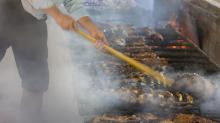Perfected everywhere from Texas to North Carolina to Kansas City, barbeque is one of the most American of food traditions. Smokey, sweet, spicy—creating the perfect blend and the “ultimate” in barbeque recipes is a matter of regional pride amongst barbeque aficionados. What is the history of this epitome of summertime foods? What is it about this particular sticky, sauce-coated delicacy that inspires so much pride in one’s hometown? Here’s a brief history of barbeque:
--It must be cooked over a wood fire. Any piece of meat smothered with barbeque sauce does not make it barbeque. Some barbequing techniques call for up to 18 hours of smoking.
--The word might have come from the Spanish “barbacoa,” but nobody knows for sure. When the Spanish landed in Caribbean, they supposedly coined the natives’ meat slow-cooked over a wooden platform “barbacoa.” Others say the word is Haitian or that it originated from a tribe in Guyana that spit-roasted its captured victims.
--Pork is the meat of barbeque. In the late 19thcentury South, pigs and corn were the most prominent ingredients available. So, pork was used for barbeque and corn bread became the side dish of choice.
--Because the cuts of meat required for it were cheap, poor Southern blacks clung to barbeque.And took it with them when they moved north. They ate it with fried okra and sweet potatoes.
--Barbeque is the great equalizer. In the 19thcentury, politicians used huge barbeques to win over their constituents. Featuring lemonade and whiskey, voters of all classes would attend these barbeques.
--Barbeque shack restaurants. Early barbeque restaurants were exceedingly simple, consisting of a barbeque shack with a bare concrete floor and corrugated tin roofs and walls. These shacks were often only open on weekends, but each “pit man” developed difficult and personal techniques for his sauce and for roasting his hogs.
--Later in the 20thcentury, three types of barbeque restaurants evolved from the barbeque shacks. The first was black-owned, the second was upscale urban white and the last were white “joints.” Still, blacks and whites of all classes frequented all three varieties of barbeque restaurant before the 1950’s and segregation.
--Memphis. Memphis barbeque is a pulled pork-shoulder with a sweet, tomato sauce that is eaten either on its own or in a sandwich.
--Kansas City.The only Midwestern barbeque specialty, Kansas City barbeque consists of ribs cooked with a dry rub.
--North Carolina.These southerners smoke the whole pig in a vinegar sauce.
--Texas.Texans shirk the pork tradition and grill beef mesquite style.
--The World Championship Barbecue Cooking Contest. Held in Memphis every year, barbeque chefs from around the world come to Tennessee to prove that their recipe is the best. Visitors can act as judges and eat the best barbeque the world has to offer. The Championships also host the Cooker Caravan, where visitors can get the latest tips on cooking barbeque, and Ms. Piggie Idol, a men-only beauty contest, in which contestants dress in tutus and pig noses and sing songs with barbeque-related lyrics.
